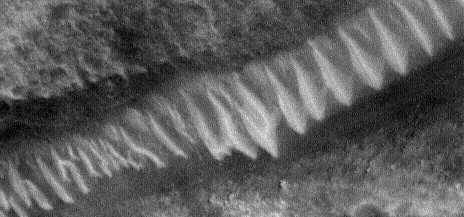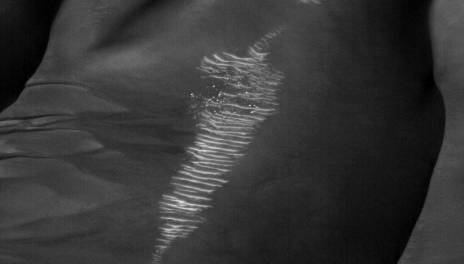Update March 2002: some news here.
Arthur C. Clarke's provocative statements at the beginning of 2001 (no irony meant) about vegetation on Mars have urged speculative efforts. One aspect of this effort is devoted to the alleged "tubes", which are probably series of natural dunes, as discussed in this page. The other aspect relates to the dark spots seen mostly on the south pole dunes, appearing in seasonal patterns.
Here is an extract of the MOC picture that was proposed by some researchers. They see in this feature a "glass pipe".

|
The feature is totally identical to sand dunes pictures seen in many MOC picture of the surface of Mars. The particularity of the alleged "glass tube" feature is that the dunes were shaped inside a narrow canyon, and thus have been shaped in an elongated feature, whereas on flat plains you can see more obviously as what they really are: dunes.
The notion of "glass" is totally irrelevant. There is absolutely no reason to see glass in the feature.
Below is an extract of MOC image M0704545.gif from the Malin Space Center web site.

|
Much evidence shows that Mars is a more complex and even hospitable planet than previously accepted by the planetary science community.
But I am quite confident that the alleged "glass pipes" mentioned by Arthur C. Clarke and presented as evidence of artificially by amateur and professional researchers have a natural explanation.
However it should be remembered that Mars has much more other anomalies, which are still heavily debated, and some of them are very far away from a natural explanation.
The real lesson to draw from these pictures is that there was indeed enough wind pressure on Mars in a more or less recent past to raise up these well shaped dune.
In compliance with the MSSS image use:
"All Mars Orbiter Camera images are used courtesy of Malin Space Science Systems. Pursuant to the Image Use Policy , all original imaging credit is given to NASA/JPL/Malin Space Science Systems."